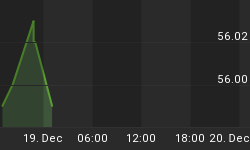Double tops or double bottoms often indicate an important change in price trends. In the case of a double top, it shows a price level at which much selling is generated. The buyers on the other hand are exhausted, and cannot generate sufficient buying pressure to move the price higher. Thus, the path of least resistance is downward.
On March 13, and again on December, 2, 2015, the U.S. Dollar Index peaked at similar prices. It's high in March was 100.39. After its December 100.51 top, the index broke shapely in price while gold simultaneous hit its $1046 low. The dollar has since been trading between 95.46 and 99.83. Later, during the last week of January, 2016 the dollar collapsed, rocketing higher the gold price.
I believe these events are significant because they suggest the possibility that a change in market psychology has occurred. Dollar bulls think 100 is high enough and it can easily go lower, while gold bulls feel 1046 is sufficiently cheap, and should go higher. The result is that the dollar has peaked, and gold has bottomed, at least in the near term.
In a recent article, HAS GOLD ENTERED A NEW BULL MARKET, OR A BULL TRAP? I stated, "Of great significance, the U.S. dollar index completed a large, nearly perfect island reversal pattern. These are very powerful, and might indicate the top of its great Bull Market that began in 2001, with lower prices to follow for a considerable period." The island formation that appears on the dollar's daily chart confirms the importance of its double top. Combined, they suggest to me that the dollar has run out of steam on the upside. At minimum, it should back and fill for a while, which should act to buoy gold.
Historically, the U.S. dollar and gold move in opposite directions. When the dollar is trending lower, gold typically rises in price, and vice-versa. The metrics that depress the dollar's price such as U.S. inflation, or the threat thereof, excessive monetary creation and the like, tend to push investors into gold. In effect, anything that erodes the purchasing power of the dollar or brings its viability into question, drives people to the safety of the yellow metal.
The dollar's double peaks occurred in March and December of last year; a period spanning nearly 6 months. Its island reversal was painted from early November, 2015 to the beginning of February; three months in length. The duration of both especially of the double top, indicate they are important. However, it remains to be seen if they represent a major price trend change, or just a temporary pause in the dollar's Bull Market.
For perspective. Gold began a 21 year long secular Bear Market in January, 1980. I do not believe it ended until March, 2001. During this period there were several impressive Bear Market rallies. Each of these moved gold believers to commit more of their hard earned money into gold, silver and their stocks. The first was from March through September, 1980, when gold moved from $455 to $730. The next was from June, 1982 to February, 1983; the yellow metal began at $295 and rose to $512. Another emerged from its February, 1985 low, and ended in December, 1987, when gold worked higher from $283 to $505. After they had run their courses, all of these Bear Market rallies went substantially lower, and damaged those believers who were drawn in, and didn't sell. There were others.
Given the magnitude of the dollar's double top and island reversal, I feel that gold's present rally will likely further extend in both price and time. In fact, I believe the dollar's weakness, as shown by these two price patterns, are largely responsible for gold's strength.
In the event that this is only a Bear Market rally, I still believe gold has the potential to test the $1400 range. As the eternal metal works higher, it should offer sufficient enticement to continue attracting buying to the major gold producing stocks, and simultaneously drive their advance. The exploration companies always lag, but the more advanced juniors are feeling some tailwind. However, as a group they normally join the gold producers and trend higher with them, several months later.
Many commentators are either moderately or wildly bullish on gold. Many of their rank have repeatedly called the end of gold's Bear Market, and will likely do so again if gold breaks below its 1046 low. To me, the dollar's double top and island reversal are of great importance. Their message is that the dollar's Bull Market has either stalled for a while, or has ended. It continues to trouble me that the gold market has shown no indication of an impressive capitulation. Too many eternal gold followers and bottom callers remain in the market. Until I envision a greater degree of certainty, I will remain on the sidelines. If this is a secular gold Bull Market the upside is enormous, so time will be on my side.
I suspect that gold's present advance is another Bear Market rally. However, it can easily extend for another 4-6 months or even longer, and substantial profits can be made by the nimble.
What Would Convince Me That Gold Can Move Far Higher
If gold is destined to move substantially higher in price, I believe a few events would have to transpire for confirmation. First, I would expect a break in the U.S. Dollar Index below its recent 92.62 low. Further, gold will trade above $1315, with the HUI surpassing 210, and both will exhibit good follow through. Finally, I would like to see how much support gold generates on its first major correction.
Something else I am pondering. I wonder if gold's rise is in anticipation of a major geopolitical event such as the threat or actual break-up of the European Union, or the break-out of war which the U.S. enters.
















